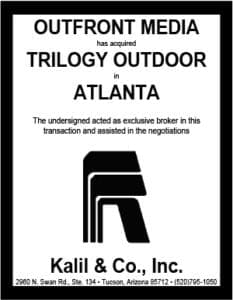
It seems like “Hurricane Season” arrives earlier and leaves later every year, and that’s certainly been the case in my hometown of Houston and the Gulf Coast. This year, the devastation caused by Hurricanes Beryl, Debbie, and several others has been enormous, tragically taking hundreds of lives and causing billions in property damage. And, as usual, the outdoor advertising industry is especially vulnerable, and it has suffered its share of losses due to storm damage.
I’ve written previously about the challenges facing the billboard operator in seeking to repair the damage caused by hurricanes and other natural disasters to his signs. In addition to the inevitable financial costs and often personal heartbreak, the operator has to confront the bureaucratic red tape of securing permission to repair his signs under vague and confusing regulations. As reported in my December 6, 2018 Billboard Insider article, the challenge is more manageable if the damaged sign conforms to the various height, size, and other regulations currently imposed by the applicable governmental jurisdiction, or of course, if it suffered only minor damage. Under the situation where the sign is conforming, the operator will still usually have to apply for a repair permit, but the sign regulations will authorize the repairs along the same lines as they would permit the new construction of the sign. Likewise, if the damage is quantifiably and objectively minor, such as just a panel or vinyl blown off, most jurisdictions will readily grant permission to repair it.
On the other hand, the challenge becomes much more meaningful when the storm damaged sign is nonconforming. As I wrote in the December 7, 2018 edition of Insider, assume the sign was legal, permitted, and complied with all of the regulations of the city when it was constructed. Sometime thereafter, however, the municipality amended the sign ordinance, to limit the height or size of signs with specifications that are lower or smaller than the sign originally constructed. Or, worse yet, the city passed new regulations completely prohibiting new off-premise signs, such as the damaged one. These types of regulations passed after the original construction of the sign render it “nonconforming” or “grandfathered,” meaning that it can legally continue to exist despite its failure to comply with the current regulations. But, most sign, zoning, or other land use regulations prohibit expanding or exacerbating the nonconformity, such as increasing the height or size of a sign that is already too tall or large. Such regulations also usually contain provisions for eventually terminating nonconforming uses or structures. One such means, for example, is to prohibit the repair of nonconforming uses and structures that have been “substantially damaged.” Thus, if the nonconforming sign was substantially damaged in a hurricane, it could only be repaired in compliance with the current height, size, and other regulations applicable to the sign. As part of the repairs, therefore, the sign would have to be lowered or downsized, if the regulations passed since construction of the sign imposed such height and size restrictions. In fact, the sign would have to be completely removed and not be eligible for repair, if the current regulations completely prohibited the type of sign, such as off-premise signs or billboards.
Now, once again, even for a sign that has become nonconforming, if the damage is quantifiably and objectively minor, most jurisdictions will permit the repairs. Sign ordinances are required to contain sufficient definitions, guidelines, or other objective tests to determine if the damage is truly minor and entitled to repair, or if it is substantial and eligible for repair only when complying with the current regulations. And, as I wrote in the September 11, 2017 issue of Insider, Constitutional Due Process is violated when a municipality fails to provide fair and adequate notice in its code as to what storm repair is permitted and what is prohibited. Precisely such a situation arose in the case of City of Webster vs SignAd, in which six of SignAd’s billboards located in the Gulf Coast community of Webster, Texas suffered varying degrees of damage due to Hurricane Alicia in August 1983. Some of the damage involved only panels or lights displaced, while other signs were completely blown down; but, regardless of the extent of damage to the signs, the Webster Sign Official denied repair permits for all of them under the code, which prohibited repairs if “substantial parts” of the sign were destroyed. The Wester Sign Code also failed to include any objective tests, guidelines, or definitions of the terms “substantial parts.” Accordingly, the trial court ruled that “the terms ‘substantial parts’ contained in [the Webster Code] violates the due process provisions of the Texas and United States Constitutions because such terms are so vague that they fail to give fair and adequate notice of what is permitted or prohibited, and they necessitate the use of unbridled discretion … in interpretation and application.” The appellate court affirmed, noting that without any definitions, parts of a sign could be both “substantial” and “insubstantial” at the same time, ”depending on whether the test used is economic, physical or functional.” As such, the court went on to rule that because “persons of common intelligence are left to guess at the meaning of that portion of the Ordinance,” the City’s actions were based on an invalid regulation, and were therefore void and unenforceable.
Since the decision in Webster vs SignAd, the City of Webster and virtually every city in Texas amended their sign codes to include objective and definitive criteria for determining when damaged signs are eligible for repairs. Under the Houston Sign Code, for example, if the cost of repairing the damage to the sign exceeds 60% of the cost to rebuild it, then the sign will be permitted for repair only if it complies with the current height, size, and other limitations in the Code. Thus, if the sign was originally built at a height of 70 feet, and the cost of repairing it was 61% or more of the cost of rebuilding it, the sign would have to be lowed to the currently permitted height of 42.5 feet when the repairs were conducted. By contrast, if the cost to repair the damage was only 59% or less, the repairs could be undertaken and the sign could remain at the nonconforming height of 70 feet. Under such a percentage test, therefore, whether a sign is substantially damaged or not is predictable based on objective criteria instead of bureaucratic subjectivity.
We still have a few more months of Hurricane Season, and I hope you and yours will be safe and secure—and your billboards don’t suffer substantial damage.
Q&A for R&F at the IBO:

The IBO conference scheduled for October 8-11 at the Sheraton Fort Worth Downtown Hotel is shaping up once again to be fun and educational. As usual, the lawyers at Rothfelder & Falick, IBO’s counsel, will be presenting on important, timely, and practical legal topics. And, for this conference, Richard, Chris, and Mike are inviting the attendees to submit their legal questions in advance, so they can do any necessary research or other preparation in answering them. The three or so questions that seems to be of most interest to the membership will be selected and answered by R & F during the session. So, send your questions to Richard Rothfelder, at rrothfelder@rothfelderfalick.com, or call him at 713-962-6300. See you in Fort Worth!
To receive a free morning newsletter with each day’s Billboard insider articles email info@billboardinsider.com with the word “Subscribe” in the title. Our newsletter is free and we don’t sell our subscriber list.
Paid Advertisement

















